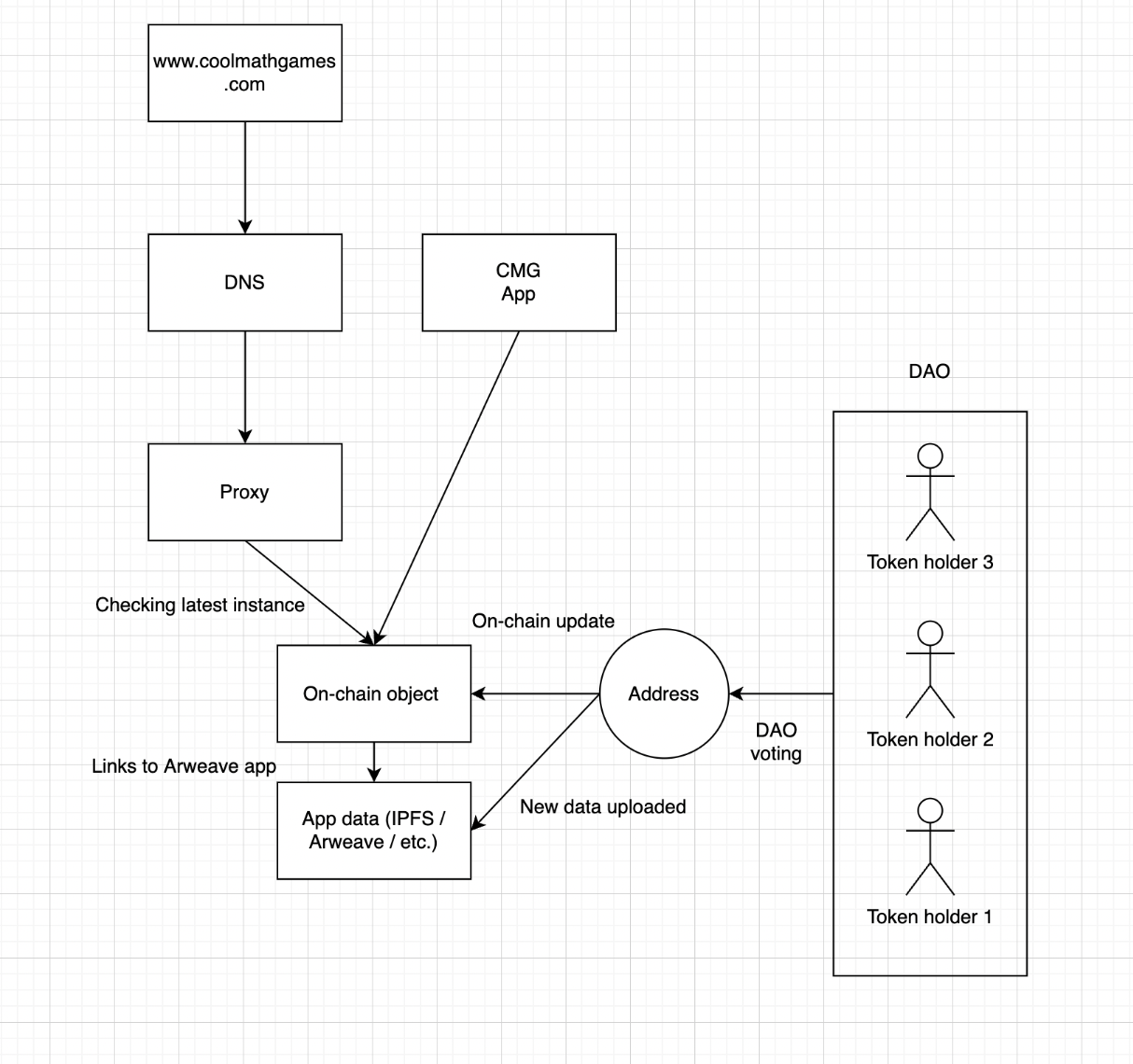Hyperapps: tokenizing programmable front-ends.

This is a cross-post from Pentagon.
Tokens changed how we think about capital, yet their innovation is currently limited to the confines of a blockchain. I propose a new primitive I’m calling “hyperapps.” I imagine that hyperapps could transform applications and drive the creation of millions of new tokens.
So what is a hyperapp?
A hyperapp is an off-chain application (i.e., website front-end) that is wholly or partially governed by an address (i.e., DAO, EOA, etc.).
A hyperapp manifests as an on-chain object containing an address, administrator right, and pointer to the application’s data (a hash to Arweave/IPFS). The administrator may update the hyperapp’s on-chain pointer to a new deployment, permeating changes across all deployed instances.
Unlike a DAO (albeit complementary), what makes a hyperapp novel is the ability to own and trade the right to update certain parts of an off-chain application. In its simplest form, a hyperapp is a website that enables on-chain governance over its front-end.
An example in practice.
For example, Coolmath Games is one of my favorite websites. While they often create the most addicting games, the experience is polluted with ads. This is no fault of Coolmath, they need to make money, and there are historically few options in Web2.
Coolmath could transcend this by becoming a hyperapp. This would transform Coolmath’s core business model. Coolmath could issue $COOL tokens that control the website’s user interface (i.e. this week’s featured games) or even govern aspects of game experiences. Advertisers may purchase $COOL to acquire digital real estate. Service providers like AWS or Mixpanel could bid to integrate into the application.
In this future, $COOL is inherently valuable, and the ability to trade the ‘right to update’ means that $COOL has a price.
This is increasingly interesting when Coolmath issues $COOL to their users.

The benefits to Coolmath Games are immense:
- Coolmath Games, the organization, unlocks liquidity and becomes well-funded via keeping some $COOL.
- Depending on what parts of the website Coolmath decide to tokenize, theoretically, anyone and everyone can become a contributor to Coolmath Games (and be incentived to do so via inherent utility, token appreciation, or direct rewards).
- Service providers, advertisers, partners, etc., could be forced to purchase and hold the token to be considered.
- The most significant users and contributors of Coolmath Games become the application owners, enabling them to play a part in dictating their future.
- Coolmath can build novel application retention and optimization strategies through $COOL.
Hyperapps present four key unlocks:
- Creating net new value
- Enabling governance of off-chain applications
- Powering complete immutability
- Blitzscaling growth
Creating net new value
Hyperapps create net new value for applications. The ability to own, trade, and update applications (and their parts) is valuable (like buying up tokens to control an app’s analytics solution or adding ads to a website). These tokens will enable developers to achieve the benefits of a token (liquidity, governance, incentives, etc.) without working on a “crypto protocol.” Actors may want to purchase these tokens for similar reasons to DeFi governance tokens, but they now control the application instead of the protocol.
This is particularly relevant given the shift in crypto sentiment towards application value capture instead of protocol value capture.
The hyperstructure thesis by Jacob Horne says, “a hyperstructure can simultaneously be free to use and also extremely valuable to own and govern.” This thesis can now be carried over to websites and consumer applications. This will disrupt how individuals assess value.
Enabling governance of off-chain applications
The creators of the hyperapps can implement governance in infinite ways. This has many implications, some of which are:
- Developers: the TAM of developers able to write front-end code is magnitudes larger than those able to write Solidity for crypto protocols; expanding the pool of potential contributors to hyperapps.
- Rage quit: if you don’t like an update, just fork it and create your hyperapp.
- Incentivized contributions: incentivize bounty work to be done on the application itself.
Creators will need to assess and experiment with many factors to ensure the success of their hyperapp: the token distribution, the existence of a DAO, how much of the application is open-sourced, etc. We will see a broad spectrum of implementations.
Becoming completely immutable
In an ideal implementation, hyperapps will be unstoppable and will not rely on DNS (ie. via access through a local application). Even if a hyperapp is changed by an on-chain actor, the blockchain still contains links to historical versions.
This future provides DeFi apps a haven. However, the more exciting piece is being able to integrate/become composable with other hyperapps without concern for downtime.
Blitzscaling applications
We’ve seen the effect of liquidity mining on DeFi protocols: it helps solve the cold start problem, attracts an early user base, and rewards them with ownership. Hyperapps may employ a similar technique for blitzscaling, incentivizing certain behaviors on their application.
Imagine earning Discord tokens for every message you send, Postmates tokens for every order you submit, and Wikipedia tokens for every page you contribute. Sites with user-generated content are likely targets, as tokenomics help solve the cold start problem while presenting endless other opportunities.
What does this mean?
Hyperapps will introduce tons of fascinating new behavior to the internet:
- Communities of builders and founders contributing to applications.
- Businesses equitize their websites and monetize in different ways than ads.
- Companies acquire hyperapps through governance. PE style investments across hyperapps.
- New types of governance will form to specialize in hyperapps.
And so much more.
Lastly, we implemented a gas-efficient version of the on-chain component here. We’ve spent a lot of time thinking about hyperapps, but it’s just an idea – reach out if you are interested in talking/thinking about them.